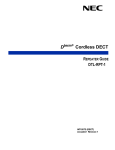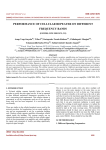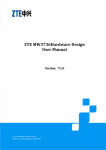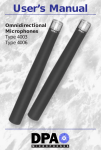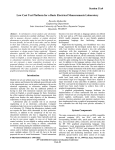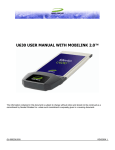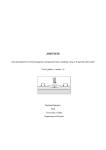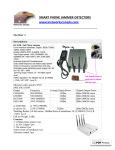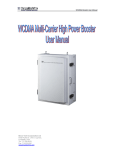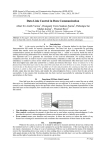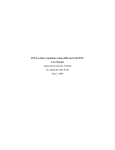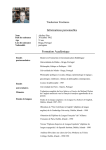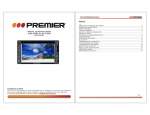Download Optimised Design Of Dual-Band Cellular Repeater At Different
Transcript
International Journal of Emerging Science and Engineering (IJESE) ISSN: 2319–6378, Volume-1, Issue-1, November 2012 Optimised Design Of Dual-Band Cellular Repeater At Different Frequency Bands (GSM 1800/ DCS, 3G) Kotaprolu Nanda Kishore, Vakkalagadda Prasad, Mada Yaswanth Manikanta, T.Ravi, Anup VSAP Josyula Yagi antenna will be mounted vertically at the roof top to the wall or pole such that it receives the maximum signal from the nearest base station and the channel to channel difference should be greater than 10db. Booster should be protected from rain and moisture such that it can give maximum radiations to patch panel antenna. The working of patch panel antenna is to radiate the amplified signal to various mobile stations. Indoor antenna should be kept at the weak coverage areas. The bandwidth specifications should be taken care as specified above. For indoor purpose the gain should be not more the 70db, if gain exceeds the specifications it has to be controlled by Manual gain control (MGC) .Noise should be less than 6db. ABSTRACT: The intended application of our Cellular Repeater is a system of duplex reception, amplification and transmission used to enhance uplink(UL) and downlink(DL) signals in areas of low signal coverage i.e.; for the situations where signal quality between the base station and the receiver is poor and communication fails. This will be helpful for cellular providers to rectify the problems of poor signal service. This Dual band Cellular Repeater consists of Bidirectional amplifier, receiving and transmitting antennas. This paper discusses our assembling process, beginning with component selection and our difficulty in obtaining the required gain according to the user requirement in the process of testing. This cellular repeater can be operated in 2 different operating frequency bands namely, GSM 1800/DCS and 3G. The operation of the repeater can be switched between the two bands depending on the user requirement using a duplexer which provides proper switching among the bands. This model helps a lot in providing efficient signal service in the weaker coverage areas in the specified band of frequency. Index terms: Bi-Directional Amplifier (BDA), Yagi-Uda antenna, Patch panel antenna, power amplifier, GSM 1800/DCS, 3G I. II. METHODOLOGY A.Different Operating Frequencies: Repeaters are available for all the different GSM frequency bands, some repeaters will handle different types of network such as multi-mode GSM, DCS, 3G repeaters however dual band systems cost significantly more. Repeater systems are available for certain Satellite phone systems, allowing the satellite phones to be used indoors without a clear line of sigh t to the satellite. The frequency table for GSM, DCS, 3G: S.No Frequency Uplink Downlink . Band Frequency(Mh Frequency z) (Mhz) 1 Digital 1710-1785 1805-1880 Communicatio n System (GSM 1800) 2 3rd Generation 1920-1980 2110-2170 (3G) INTRODUCTION A dual band cellular repeater helps the service provider to rectify the poor signal service. It can be operated in two different operational frequencies according to the user’s convenience and requirement. This cellular repeater is economical as all the components used are of low cost and hence total cost has been integrated. It is user-friendly and eco-friendly. These are similar to the cellular broadcast towers used by the network providers for broadcasting, but are much smaller and are recommended to use for a particular building only. Modern cellular repeater amplifiers rebroadcast cellular signals inside the building. The systems usually use an external directional antenna to collect the best cellular signal, which is then transmitted to an amplifier unit which amplifies the signal, and retransmits it locally, providing significantly improved signal strength. The more advanced models often also allow multiple cell phones to use the same repeater at the same time, so are suitable for commercial as well as home use. B.External directional antenna (Yagi Uda Antenna): Although some of the less expensive models do not include an external directional antenna, they are crucial to providing significant signal strength gain. This is because the antenna can be oriented and located outside to provide the best possible signal, usually aligned with the nearest cell tower. Generally speaking the larger the external antenna the better the signal - although even a small, correctly oriented external antenna should provide better signal than the internal antenna on any cell phone. These can either be fitted by professionals or will include a signal strength monitor for easy alignment. Manuscript received November 19, 2012. Kotaprolu Nanda Kishore, Electronics And Communication Engineering, K L UNIVERSITY, Vijayawada, India. Vakkalagadda Prasad, Electronics And Communication Engineering, KL UNIVERSITY, Vijayawada, India. Mada Yaswanth Manikanta, Electronics And Communication Engineering, K L UNIVERSITY, Vijayawada, India. T.Ravi, Associate Professor, Electronics And Communication Engineering, K L UNIVERSITY, Vijayawada, India. Anup VSAP Josyula, Electronics And Communication Engineering, K L UNIVERSITY, Vijayawada, India. 1 Optimised Design Of Dual-Band Cellular Repeater At Different Frequency Bands (GSM 1800/ DCS, 3G) antennas are intrinsically polarized, cell phones perform best when their antennas are oriented parallel to the booster's antenna - although within reasonable proximity the booster's signal will be strong enough that the orientation of the cell phone's antenna will not make a significant difference in usability. Radiation Pattern of Patch Panel Antenna: a. Design Specifications of the Yagi Antenna C. Internal rebroadcast antenna (Patch Panel Antenna): The better systems will generally include an internal monopole antenna (although the type of antenna is far from standardized) for rebroadcasting the signal internally - the advantage of using a monopole antenna is that the signal will be equally distributed in all directions (subject, of course, to attenuation from obstacles). Because all radio 2 International Journal of Emerging Science and Engineering (IJESE) ISSN: 2319–6378, Volume-1, Issue-1, November 2012 D. BI-DIRECTIONAL AMPLIFIER: III. CELLULAR REPEATER INSTALLATION PROCEDURE Duplex filter LNA Power amplifier Duplex filter Band pass filter A basic Repeater mainly consists of Low noise Amplifier, Band Pass filter, Power Amplifier and Duplex filters. The signal from the Yagi Uda Antenna is sent to the Duplex filter and from the duplex filter it is sent to Low noise Amplifier module. Low noise amplifier as a module is made up of MGA 31589, Saw filters and ABA54563. These are the amplifiers which provide a sufficient amount of gain to the signal and are sent to the band pass filter. All these amplifiers are provided with biasing components which include capacitors and inductors. Attenuation pads are provided to get the required amount of gain at each and every stage. Signal from the Low Noise Amplifier (LNA) is sent to the Band Pass filter which selects the particular bandwidth in which the signal has to be amplified. The Bandwidth is selected as per the user requirement in the frequency bands (DCS, and 3G). This Required signal is sent to the Power amplifier module. This contains saw filters, ASL 19w and ABA54563, Amplifier which amplifies the signal in the required bandwidth. All the Amplifiers are provided with the required biasing components. The Amplified signal is given to the Duplex filter which separates out the low frequencies and high frequencies and is given to the Mobile Server. In Each and every module 220pf capacitors are placed in the RF path to block the DC voltage. When tested through a Network analyzer it should not receive any DC voltage hence the 220pf capacitors are placed in the RF path. The Repeater is supplied with a 5V power supply. Uplink and downlink frequency Response for DCS and 3G are tested in the network analyzer and the results obtained are mentioned below. Check Rx level, Receiving Quality and Ch to Ch power difference using cell phone, which has net monitor software. The following specifications have to be met at pick up point. Rx level: -60±10dBm. Receiving Quality: 0 to +3 Ch to Ch power difference : >7dB. If the above parameters do not meet; then change the pickup position, such that above specifications are met. Fix Yagi antenna in vertical orientation towards BTS direction, such that maximum Rx level is received. Connect one end of the RF cable to Yagi and other end to BTS/Yagi antenna port of the Booster. Ensure that connections are proper and effective. Locate convenient place for booster and fix it. If it is outdoor installation, ensure that booster is protected from rain. Fix the power cord to the booster and connect the PSU to the supply point. Fix Patch antenna in vertical position, where the boosted signal is required. Ensure that Patch antenna is fixed at least 2 meters away from the booster. Ensure that cables connected to the booster do not overlap each other. Minimize cable length to avoid cable loss. Switch on the booster. Adjust the manual gain control if required. Finally note down CID, CH & LAC. IV. SIMULATIONS AND DISCUSSIONS: The Graphs mentioned below depict the gain obtained for uplink and downlink frequencies for the DCS and 3G frequency bands. The DCS and 3G are connected to a duplexer and we can operate all the two at a time or individually this depends upon the user requirement. All the two uplink frequencies can be observed at a time and similarly all the two downlink frequencies can be observed at a time on the network analyzer screen. We can also observe the increase in bandwidth as the frequency of operation increases. Hence when DCS and 3G are maintained at same gain we can observe that 3G has more bandwidth compared to DCS BLOCK DIAGRAM OF UPLINK 3 Optimised Design Of Dual-Band Cellular Repeater At Different Frequency Bands (GSM 1800/ DCS, 3G) b. 3G 2100 MHz Frequency Response d.DUAL BAND (DCS, 3G) FREQUENCY RESPONSE c. DCS 1800Mhz Frequency Response a. DCS UPLINK Gain : 58.679dB Frequency Range: 1710MHz – 1785MHz 4 International Journal of Emerging Science and Engineering (IJESE) ISSN: 2319–6378, Volume-1, Issue-1, November 2012 b. DCS DOWNLINK Gain : 60.025dB Frequency Range :1805MHz – 1880 MHz enhanced in low coverage areas with the help of these boosters. We have observed the amplifications of 3G speed when booster is ON and OFF. Hence, practically also proved the importance of repeater in enhancing the signal. Finally, we conclude by saying that repeaters can improve the signal strength to such an extent that everyone can receive signals without having any disturbances. c. 3G UPLINK Gain: 59.611dB Frequency Range :1920MHz – 1980MHz REFERENCES: [1] K. V. S. Rao, P. V. Nikitin and S. Lam, “Antenna design for UHF d. 3G DOWNLINK Gain : 65.287dB Frequency Range :2110MHz – 2170MHz a. RFID tags: A review and a practical application,” IEEE Transactions on Antennas and Propagation, vol. 53, no. 12, pp. 3870-3876, Dec. 2005. [2] K.P. Ray and Y. Ranga, “CPW-fed modified rectangular printed monopole antenna with slot,” Microwave and Optoelectronics Conference, 2007 IMOC 2007 SBMO/IEEE MTT-S International, pp.79-81, Oct. 29 2007-Nov. 1 2007. Performance of 3G: [3] C. Balanis, Antenna Theory, Analysis and Design, 3rd edition, New York: Wiley, 2005. [4] R. C. Baraniuk, V. Cevher, and M. B. Wakin, “Low-dimensional models for dimensionality reduction and signal recovery, a geometrical perspective,” Proc. IEEE, vol. 98, no. 6, pp. 959–971,Jun. 2010. [5] O. M. Bucci, G. D’Elia, and M. D. Migliore, “A new strategy to reduce the truncation error in near-field far-field transformations,” Radio Sci.,vol. 35, no. 1, pp. 3–17, Jan.–Feb. 2000. [6] 4S Telecom (P) LTD. BANGALORE User Manual Variation of the signal strength before and after switching of the cellular repeater: When the cellular repeater is in OFF state DOWNLINK (Mb/s) UPLINK (Mb/s) LATENCY (ms) 0.56 0.14 68 0.71 0.59 68 0.81 0.2 69 Kotaprolu Nanda Kishore is born in Vijayawada, Krishna District, Andhra Pradesh, India on 10th July 1992 and currently pursuing B.TECH 4th year in Electronics and Communication Engineering in K.L.University with specialization in Networking. Areas of interest are Tele communication, Digital Communication and Antennas. When the cellular repeater is in ON state DOWNLINK (Mb/s) UPLINK (Mb/s) LATENCY (ms) 1.92 1.79 62 2 2.51 2.02 2.18 58 62 Vakkalagadda Prasad is born in Vellatur, Guntur District, Andhra Pradesh, India on 13th April 1992 and currently pursuing B.TECH 4th year in Electronics and Communication Engineering in K.L.University with specialization in Networking. Areas of interest are Telecommunication, Digital Communication and Antennas. Mada Yaswanth Manikanta is born in Guntur, Guntur District, Andhra Pradesh, India on 14th June 1992 and currently pursuing B.TECH 4th year in Electronics and Communication Engineering in K.L.University with specialization in Networking. Areas of interest are Tele-communication, Digital Communication and Antennas. If we observe from above table, the amplification of signal has been almost seven times the normal signal. V. CALCULATION OF THE FINAL OUTPUT GAIN: T. Ravi(Associate Professor) did his B. Tech at KSRMCE kadapa and later he did his M. E at Karunya University and M. Tech in JNTU Kakinada. He Worked as HOD in Universal College of Engg. and Tech. Guntur. And Presently he is working as a Assoc. Prof in K. L. University. His interested areas are Image Processing and Signal Processing By using the net monitor software the gain in the required channel and its neighbor channels can also be calculated. Using that process the signal gain in a particular channel is obtained. Then the gain of the External Directional antenna is added to that signal gain, to the resultant gain the return loss of the cable is added. To that gain the Internal Rebroadcast antenna gain is added. Finally the resultant gain gives the output gain with which the weaker signal is boosted to increase the signal service in the particular area. VI. Anup VSAP Josyula is born in Bhimavaram, West Godavari District, Andhra Pradesh ,India on 25th June 1991 and currently pursuing B.TECH 4th year in Electronics and Communication Engineering in K.L.University with specialization in Communications. Areas of interests are Linear integrated circuit applications, Digital Logic Design and Antennas. CONCLUSION: We analyzed from our observations that signal can be 5






